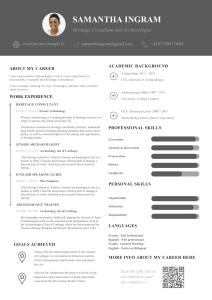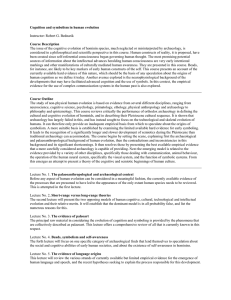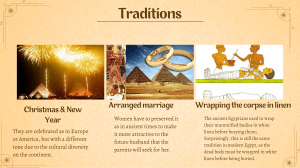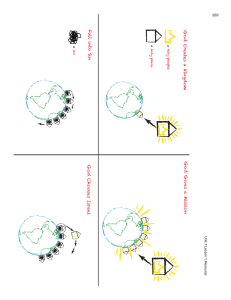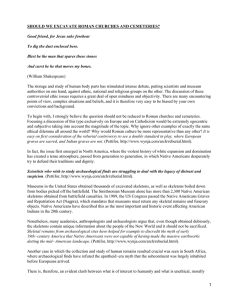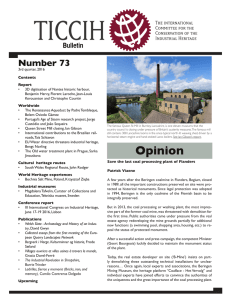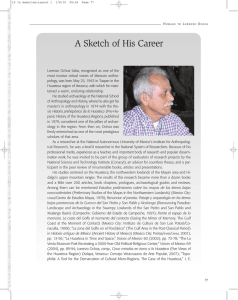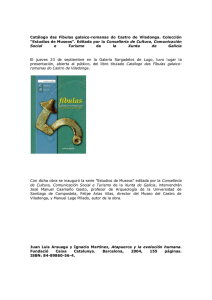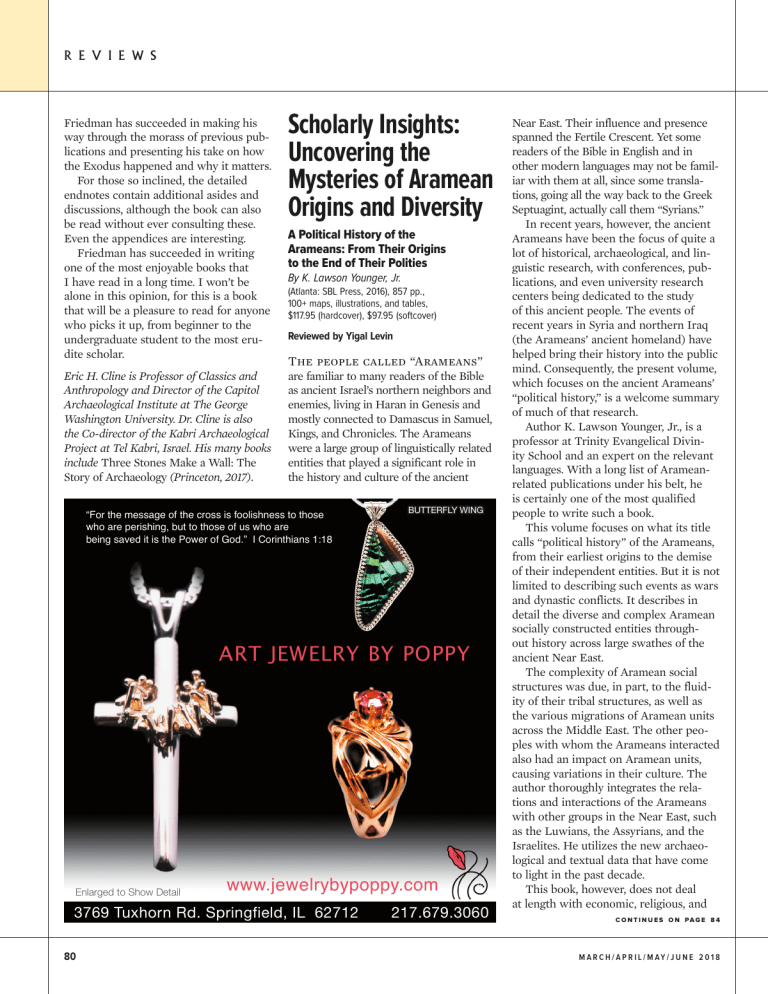
R E V I E W S Friedman has succeeded in making his way through the morass of previous publications and presenting his take on how the Exodus happened and why it matters. For those so inclined, the detailed endnotes contain additional asides and discussions, although the book can also be read without ever consulting these. Even the appendices are interesting. Friedman has succeeded in writing one of the most enjoyable books that I have read in a long time. I won’t be alone in this opinion, for this is a book that will be a pleasure to read for anyone who picks it up, from beginner to the undergraduate student to the most erudite scholar. Eric H. Cline is Professor of Classics and Anthropology and Director of the Capitol Archaeological Institute at The George Washington University. Dr. Cline is also the Co-director of the Kabri Archaeological Project at Tel Kabri, Israel. His many books include Three Stones Make a Wall: The Story of Archaeology (Princeton, 2017). Near East. Their influence and presence Scholarly Insights: spanned the Fertile Crescent. Yet some readers of the Bible in English and in Uncovering the other modern languages may not be familMysteries of Aramean iartions,withgoingthemallattheall,waysincebacksometo thetranslaGreek Septuagint, actually call them “Syrians.” Origins and Diversity In recent years, however, the ancient A Political History of the Arameans: From Their Origins to the End of Their Polities By K. Lawson Younger, Jr. (Atlanta: SBL Press, 2016), 857 pp., 100+ maps, illustrations, and tables, $117.95 (hardcover), $97.95 (softcover) Reviewed by Yigal Levin The people called “Arameans” are familiar to many readers of the Bible as ancient Israel’s northern neighbors and enemies, living in Haran in Genesis and mostly connected to Damascus in Samuel, Kings, and Chronicles. The Arameans were a large group of linguistically related entities that played a significant role in the history and culture of the ancient “For the message of the cross is foolishness to those who are perishing, but to those of us who are being saved it is the Power of God.” I Corinthians 1:18 BUTTERFLY WING ART JEWELRY BY POPPY Enlarged to Show Detail www.jewelrybypoppy.com 3769 Tuxhorn Rd. Springfield, IL 62712 80 217.679.3060 Arameans have been the focus of quite a lot of historical, archaeological, and linguistic research, with conferences, publications, and even university research centers being dedicated to the study of this ancient people. The events of recent years in Syria and northern Iraq (the Arameans’ ancient homeland) have helped bring their history into the public mind. Consequently, the present volume, which focuses on the ancient Arameans’ “political history,” is a welcome summary of much of that research. Author K. Lawson Younger, Jr., is a professor at Trinity Evangelical Divinity School and an expert on the relevant languages. With a long list of Arameanrelated publications under his belt, he is certainly one of the most qualified people to write such a book. This volume focuses on what its title calls “political history” of the Arameans, from their earliest origins to the demise of their independent entities. But it is not limited to describing such events as wars and dynastic conflicts. It describes in detail the diverse and complex Aramean socially constructed entities throughout history across large swathes of the ancient Near East. The complexity of Aramean social structures was due, in part, to the fluidity of their tribal structures, as well as the various migrations of Aramean units across the Middle East. The other peoples with whom the Arameans interacted also had an impact on Aramean units, causing variations in their culture. The author thoroughly integrates the relations and interactions of the Arameans with other groups in the Near East, such as the Luwians, the Assyrians, and the Israelites. He utilizes the new archaeological and textual data that have come to light in the past decade. This book, however, does not deal at length with economic, religious, and C O N T I N U E S O N PA G E 8 4 M A R C H / A p R I L / M AY / J u n E 2 0 1 8 S T R ATA A N S W E R S C O N T I N U E D F R O M PA G E 8 0 How Many? (from p. 15) Answer: 14 During his incredibly busy career as editor of multiple magazines, Hershel Shanks has also authored or co-authored more than a dozen books. Thick or slim, they include: • The City of David: A Guide to Biblical Jerusalem (1973) • Judaism in Stone: The Archaeology of Ancient Synagogues (1979) • The Dead Sea Scrolls After Forty Years (with James C. VanderKam, P. Kyle McCarter, Jr., and James A. Sanders; 1991) • The Rise of Ancient Israel (with William G. Dever, Baruch Halpern, and P. Kyle McCarter, Jr.; 1992) • In the Temple of Solomon and the Tomb of Caiaphas (1993) • Jerusalem: An Archaeological Biography (1995) • The Mystery and Meaning of the Dead Sea Scrolls (1999) • 101 Best Jewish Jokes (1999) • The Brother of Jesus: The Dramatic Story & Meaning of the First Archaeological Link to Jesus & His Family (with Ben Witherington III; 2003) • The Copper Scroll and the Search for the Temple Treasure (2007) • The Dead Sea Scrolls: What They Really Say (2007) • Jerusalem’s Temple Mount: From Solomon to the Golden Dome (2007) • The World’s Oldest Tallit? (2008) • Freeing the Dead Sea Scrolls and Other Adventures of an Archaeology Outsider (autobiography; 2010) This impressive list does not include the numerous supplemental issues to BAR and edited volumes, some of which appeared in multiple printings, re-editions, and translations. To set the record straight, here are the 15 books that Hershel Shanks has edited: • The Art and Craft of Judging: The Decisions of Judge Learned Hand (1968) • Recent Archaeology in the Land of Israel (with Benjamin Mazar; 1984) • Ancient Israel: A Short History from Abraham to the Roman Destruction of the Temple (1988, etc.) • Archaeology and the Bible: The Best of BAR, 2 vols. (with Dan P. Cole; 1990) • Christianity and Rabbinic Judaism: A Parallel History of Their Origins and Early Development (1992, etc.) • Understanding the Dead Sea Scrolls (1992) • The Search for Jesus (with Stephen J. Patterson, Marcus J. Borg, and John Dominic Crossan; 1994) • Frank Moore Cross: Conversations with a Bible Scholar (1994) • Feminist Approaches to the Bible (with Phyllis Trible, Tikva FrymerKensky, Pamela J. Milne, and Jane Schaberg; 1995) • Archaeology’s Publication Problem, 2 vols. (1996; 1999) • Abraham & Family: New Insights into the Patriarchal Narratives (2000) • The City of David: Revisiting Early Excavations (2004) • Scholars on the Record: Insightful Interviews on Bible and Archaeology (2009) • Partings: How Judaism and Christianity Became Two (2013) • 40 by 40: Forty Groundbreaking Articles from Forty Years of Biblical Archaeology Review (2015) Finally, we should not fail to mention these two laborious compilations that are a category of their own: • Who’s Who in Biblical Studies and Archaeology, 1986–1987 (1986) 84 • Who’s Who in Biblical Studies and Archaeology, 1993 (1993) other cultural aspects of the ancient Arameans. In a conversation that we had some time ago, Younger revealed to me that he is now working on a book about the religion of the Arameans, which will certainly be a welcome companion to the present volume. Using a regional approach to investigate the wide-ranging Aramean polities, the author divides his study into four regions: the Jezirah, where Assyrian power and influence were a particular challenge; the Anatolian north Syria, where in the Iron I and II periods one encounters the Luwian-Aramean cultural symbiosis; the northern Levant (central and southern Syria)—which is still obscure in many ways; and southern Mesopotamia, where indigenous Babylonians, Chaldean groups, and the geography combined to create a very different environment for the Aramean entities. Younger presents an impressive array of written sources and archaeological data. He also makes extended use of the Biblical materials, especially concerning the kingdom of Aram-Damascus, wading through a wide range of issues that have been at the center of debate for years: the accuracy of books such as Samuel, Kings, and Chronicles when describing the history of the kingdoms of Israel and Judah, and, inter alia, their various references to Aram-Damascus and the other Aramean states. While he does not avoid the issues, his attitude is basically positivist: He tends to accept carefully the Biblical record, unless it is disproven by other data. So who, or what, were the Arameans? Tribes, kingdoms, or “socially constructed units”? Did they all share a common origin? As this book shows, using a vast array of sources, the Arameans were spread over a vast area, experienced different lifestyles, and were known by different names. As Younger states in his concluding words, no other people in the ancient Near East was as impacted by the Assyrians at all stages of their development as were the Arameans. However, as he also points out, the one thing that they did all have in common, as far as we know, is the Aramaic language. And as the Assyrian Empire M arch / A p ril / M ay / J u n e 2 0 1 8 swallowed up all of the Aramean polities, it also ingested masses of Aramaic speakers, along with their scribes and their literary traditions. Aramaic eventually replaced Akkadian as the lingua franca of the entire Middle East. The Aramaic language was the language of administration and commerce of the Persian Empire, the language commonly spoken in the Hellenistic Levant, the language of the earliest Christians, of the Jewish Targum, of the Talmud and the Kaddish, and of the Syriac and “Assyrian” churches. Aramaic is spoken by small communities to this day and has turned out to be the Arameans’ most lasting legacy. K. Lawson Younger, Jr., is to be commended for bringing early Aramean history together in what is truly an excellent work of scholarship. Yigal Levin is Associate Professor in the Department of Jewish History at 86 Bar-Ilan University, Israel. He also heads Bar-Ilan’s multidisciplinary program for Judaic Studies and teaches at Jerusalem University College. He has worked on staff at several excavations in Israel. His latest book is The Chronicles of the Kings of Judah: 2 Chronicles 10–36: A New Translation and Commentary (London: Bloomsbury, T & T Clark, 2017). History of BAS continued from page 23 (January/February 2018). We feel very fortunate to have him along with our marvelous staff to take us bravely into the future. Hershel, now as Editor Emeritus, will have a column in the magazine when he wants and will continue to make many contributions to the society. As I conclude this short history, I can’t help but feel exceedingly proud of everyone, past and present, associated with our flagship publication, Biblical Archaeology Review, and of the Biblical Archaeology Society that produces this magazine. There have been many highs and some lows. Foremost, I appreciate the network of people who have lent their expertise, energy, and ingenuity over the years to making Hershel’s vision a reality. Thank you for your contributions. It has been a lot of fun to build a high-quality and sustainable organization with you. I know Hershel’s legacy and entrepreneurial spirit will keep pushing us into new frontiers. Working with Hershel all these years has been particularly meaningful for me. I have had the opportunity to learn much about our subject matter and about the business of running an organization. What is especially precious to me is what Hershel has helped me learn about myself and, yes, how to deal with difficult people. a M arch / A p ril / M ay / J u n e 2 0 1 8
